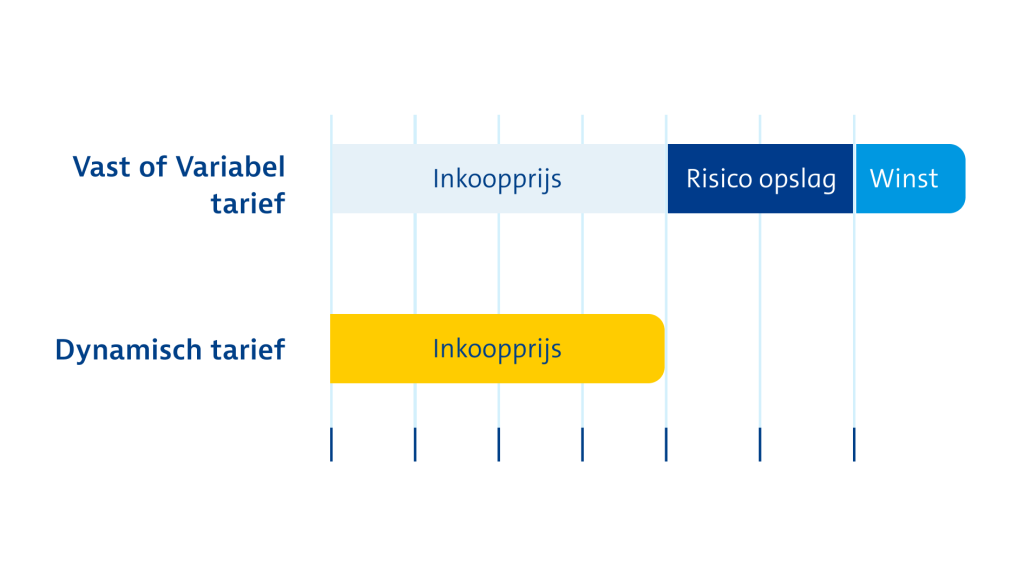
'Smart battery control. Buying and selling your power with positive results.' That sounds super interesting, but you probably don't know exactly what it entails yet . After reading this piece, you'll know once tuk more about dynamic energy contracts with hourly pricing, weather forecasting and algorithms.
It is good to know differences are in the control of Blauhoff batteries, depending on the country you live in. This is due to differences in taxes and measures, for example, balance or no balance.
Dynamic energy contracts
Recently, hourly price contracts have been offered to individuals by energy suppliers. These contracts give you access to the wholesale market (Epex) for electricity. On this market, the price for a kWh of electricity is different every hour, depending on the amount of supply and demand. Prices are set a day in advance (around 1 p.m.) and announced.
Generally, due to higher demand, power is more expensive in the morning and evening, and cheaper in the afternoon. The increasing supply of solar power during the day pushes this price further and further down. Sometimes the price is even negative! So then you get money to take power from the grid. 'Just charge that battery full' we hear you say, well that's exactly what we do.
Because of the net-metering regulation, few households in the Netherlands still have a home battery. This is logical, because we use the grid as one big collective battery. You offset the electricity you feed back against the electricity you purchase. Only if you deliver more back on an annual basis than you purchase will you receive a lower feed-in compensation for that extra portion. This works slightly differently with a dynamic energy contract with hourly prices. Here you get the price for both purchase and feed-in to the grid that applies in that hour. Netting is then only about the taxes, and that is per kWh. Here is an example:
- You buy 1kWh at a price of €0.10
- You sell 1kWh for €0.25
- On your statement you will see the following:
- Power cost: €0.25 - €0.10 = €0.15
- Taxes: 1kWh - 1kWh = 0

You then made 15 cents profit on the sale of your power and you don't have to pay taxes, because that's where sales are offset against purchases.
As a result, control in the Netherlands is very simple: charge at cheap times, discharge at expensive times. Charging and discharging the battery can serve two purposes. Charging at cheap moments can ensure that you purchase power from the grid and store it in your battery, or if there is generation, that you do not feed the solar power back to the grid cheaply, but store it in your battery.
Discharging can cause you to sell the previously stored power for a high price, or to use this cheap power yourself, thereby avoiding having to buy expensive power from the grid. Often your battery and/or your inverter is not large enough to store all your generation or needed power. So by maximizing charging and discharging at the right hours you can make the best "trade," or avoid cheap feed-in and expensive purchase. So we don't have to let the algorithm predict your generation and consumption.
Belgium
In Belgium, no scheme like the balancing scheme is in place yet. Only solar panel owners with an "old" meter still have the system of the revolving counter. When they feed back to the grid, the meter turns back and the consumption is compensated.
When you have a digital meter, you have to pay taxes for taking from the grid, which you do not get back when selling power. Only if the price difference between different hours in one day is large enough to cover the difference in taxes can you "trade" power (Buy power at a low price, and later sell it again for a profit).
For most days, Blauhoff Home predicts the generation from your solar panels and your consumption, and uses that information to determine whether you need extra power, or have excess. If you need extra power, because you don't have enough generation, the battery will recharge itself at cheap times. You use this power from your battery when the price is high. Do you have power left over? For example, in the summer when you have a lot of generation and lower consumption, the battery discharges when the price is highest. So you get the best price for your power. The battery is then ready for the next beautiful summer day!
